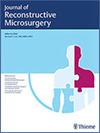Lymphovenous Bypass for Immediate Lymphatic Reconstruction in Breast Cancer Patients Undergoing Axillary Lymph Node Dissection: Minimizing the Risk of Upper Extremity Lymphedema.
IF 2.2
3区 医学
Q2 SURGERY
引用次数: 0
Abstract
BACKGROUND Studies have shown a significant reduction in breast cancer-related lymphedema (BCRL) rates in patients undergoing complete axillary lymph node dissection (cALND) combined with immediate lymphatic reconstruction (ILR) using lymphovenous bypass (LVB).The purpose of this study was to determine if ILR with LVB at the time of cALND results in a decreased incidence of BCRL and its impact on patient quality of life (QOL). METHODS In this prospective cohort study, patients ≥ 18 years requiring cALND underwent ILR from 2019 to 2021. The primary outcome was bilateral upper limb volumes measured by Brørson's truncated cone formula and the Pero-System (3D Körper Scanner). The secondary outcome was QOL measured by the Lymphedema Quality of Life (LYMQOL) arm patient-reported outcome measurement. RESULTS Forty-two patients consented to ILR using LVB. ILR was completed in 41 patients with a mean of 1.9 ± 0.9 lymphovenous anastomosis performed. Mean age of patients was 52.4 ± 10.5 years with a mean body mass index of 27.5 ± 4.9 kg/m2. All patients (n = 39, 100%) received adjuvant therapy after ILR. Mean follow-up was 15.2 ± 5.1 months. Five patients met criteria for lymphedema throughout the duration of the study (12.8%), with two patients having resolution, with an overall incidence of 7.7% by the end of the study period. Patients with lymphedema were found to have statistically significant lower total LYMQOL values at 18 months (8.44 ± 1.17 vs. 3.23 ± 0.56, p < 0.001). A mean increase of 0.73 ± 3.5 points was observed for overall QOL average for upper limb function at 18 months compared with 3 months (t = 0.823, p = 0.425). CONCLUSION This study showed an incidence of 7.7% lymphedema development throughout the duration of study. We also showed that ILR has the potential to reduce the significant long-term adverse outcomes of lymphedema and improve QOL for patients undergoing cALND.为接受腋窝淋巴结切除术的乳腺癌患者立即进行淋巴重建的淋巴静脉旁路术:将上肢淋巴水肿的风险降至最低。
背景研究表明,在接受完全腋窝淋巴结清扫术(cALND)并使用淋巴-静脉旁路(LVB)进行即时淋巴重建(ILR)的患者中,乳腺癌相关淋巴水肿(BCRL)发生率显著降低。本研究旨在确定在进行 cALND 时使用 LVB 进行 ILR 是否会降低 BCRL 的发生率及其对患者生活质量(QOL)的影响。主要结果是通过布罗森截锥公式和Pero-System(3D Körper扫描仪)测量的双侧上肢体积。次要结果是通过淋巴水肿生活质量(LYMQOL)臂患者报告结果测量法测量的 QOL。41名患者完成了ILR,平均进行了1.9 ± 0.9次淋巴管吻合。患者的平均年龄为(52.4 ± 10.5)岁,平均体重指数为(27.5 ± 4.9)kg/m2。所有患者(n = 39,100%)在ILR后都接受了辅助治疗。平均随访时间为 15.2 ± 5.1 个月。在整个研究期间,有五名患者达到了淋巴水肿的标准(12.8%),其中两名患者的淋巴水肿得到了缓解,研究结束时的总发生率为 7.7%。研究发现,淋巴水肿患者在18个月时的LYMQOL总值明显较低(8.44 ± 1.17 vs. 3.23 ± 0.56,p < 0.001)。结论 本研究显示,在整个研究期间,淋巴水肿发生率为 7.7%。我们还表明,ILR 有可能减少淋巴水肿的长期不良后果,并改善接受 cALND 患者的 QOL。
本文章由计算机程序翻译,如有差异,请以英文原文为准。
求助全文
约1分钟内获得全文
求助全文
来源期刊
CiteScore
4.50
自引率
28.60%
发文量
80
审稿时长
1 months
期刊介绍:
The Journal of Reconstructive Microsurgery is a peer-reviewed, indexed journal that provides an international forum for the publication of articles focusing on reconstructive microsurgery and complex reconstructive surgery. The journal was originally established in 1984 for the microsurgical community to publish and share academic papers.
The Journal of Reconstructive Microsurgery provides the latest in original research spanning basic laboratory, translational, and clinical investigations. Review papers cover current topics in complex reconstruction and microsurgery. In addition, special sections discuss new technologies, innovations, materials, and significant problem cases.
The journal welcomes controversial topics, editorial comments, book reviews, and letters to the Editor, in order to complete the balanced spectrum of information available in the Journal of Reconstructive Microsurgery. All articles undergo stringent peer review by international experts in the specialty.
文献相关原料
| 公司名称 | 产品信息 | 采购帮参考价格 |
|---|

 求助内容:
求助内容: 应助结果提醒方式:
应助结果提醒方式:


